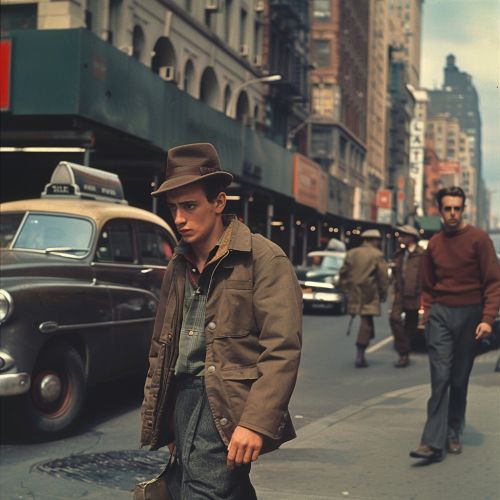The Catcher in the Rye
Introduction
The Catcher in the Rye is a novel by J.D. Salinger, first published in 1951. The novel has been a staple of American literature and has garnered both critical acclaim and controversy. It is often noted for its themes of teenage angst and alienation, as well as its critique of the superficiality in society. The protagonist, Holden Caulfield, has become an iconic figure in literature, representing the voice of teenage rebellion and disillusionment.
Plot Summary
The novel is narrated by Holden Caulfield, a sixteen-year-old who has been expelled from his prep school, Pencey Prep. The story is set in the 1950s and follows Holden's experiences in New York City over a few days. He interacts with various characters, including his younger sister Phoebe, old friends, and strangers, while grappling with his own mental health issues and existential questions.
Holden's journey is marked by his desire to protect the innocence of children, which is symbolized by his fantasy of being "the catcher in the rye," a guardian who saves children from falling into the corruption of adulthood. The novel ends ambiguously, with Holden in a mental institution, contemplating his future.
Themes
Alienation and Isolation
One of the central themes of The Catcher in the Rye is alienation. Holden feels disconnected from the world around him and often isolates himself as a form of self-protection. This alienation is both a source of his pain and a way to shield himself from the perceived phoniness of the adult world.
Innocence and Childhood
Holden's obsession with preserving innocence is another key theme. He is deeply affected by the death of his younger brother, Allie, and is determined to protect his sister Phoebe and other children from the harsh realities of life. This desire is encapsulated in his fantasy of being the "catcher in the rye."
Phoniness of the Adult World
Holden frequently criticizes the superficiality and hypocrisy he perceives in adults. He uses the term "phony" to describe people who are insincere or superficial. This critique extends to various aspects of society, including education, religion, and social interactions.
Mental Health
The novel also explores issues of mental health. Holden exhibits signs of depression, anxiety, and post-traumatic stress disorder, particularly in relation to Allie's death. His mental state deteriorates throughout the novel, culminating in his stay at a mental institution.
Characters
Holden Caulfield
Holden is the protagonist and narrator of the novel. He is a complex character, marked by his cynicism, sensitivity, and deep-seated fear of growing up. His narrative voice is characterized by its colloquial and candid tone.
Phoebe Caulfield
Phoebe is Holden's ten-year-old sister, whom he adores. She represents the innocence and purity that Holden wishes to protect. Despite her young age, Phoebe is perceptive and often serves as Holden's confidante.
Allie Caulfield
Allie is Holden's younger brother who died of leukemia. His death profoundly affects Holden, who frequently reminisces about Allie's intelligence and kindness. Allie symbolizes the innocence that Holden longs to preserve.
Mr. Antolini
Mr. Antolini is Holden's former English teacher, who offers him advice and a place to stay. He represents a more nuanced view of adulthood, though his actions later in the novel complicate Holden's perception of him.
Literary Devices
Symbolism
The novel is rich in symbolism. The most prominent symbol is the "catcher in the rye," representing Holden's desire to save children from losing their innocence. Other symbols include the red hunting hat, which signifies Holden's uniqueness and individuality, and the Museum of Natural History, which represents his longing for a world that is unchanging and predictable.
Narrative Style
The novel is written in the first person, with Holden as the unreliable narrator. His stream-of-consciousness narrative style provides insight into his thoughts and feelings but also leaves room for ambiguity and interpretation.
Language and Diction
Salinger's use of colloquial language and slang adds authenticity to Holden's voice. The informal diction reflects Holden's rebellious nature and his disdain for the formalities of the adult world.
Critical Reception
Since its publication, The Catcher in the Rye has been both celebrated and criticized. It has been praised for its authentic portrayal of teenage angst and its critique of societal norms. However, it has also faced censorship and controversy due to its use of profanity and its exploration of complex themes such as mental health and sexuality.
Cultural Impact
The novel has had a lasting impact on American culture and literature. Holden Caulfield has become an enduring symbol of teenage rebellion and disillusionment. The book has influenced numerous writers and has been referenced in various forms of media, including films, music, and other literary works.
Adaptations
Despite its popularity, The Catcher in the Rye has never been officially adapted into a film or television series. Salinger was famously protective of his work and refused to sell the film rights. However, the novel's themes and characters have inspired numerous unofficial adaptations and references in popular culture.
Controversies
The novel has been the subject of numerous controversies, primarily due to its language and themes. It has been banned or challenged in various schools and libraries, often cited as inappropriate for younger readers. Despite this, it remains a widely studied and discussed work in academic settings.
See Also
References


